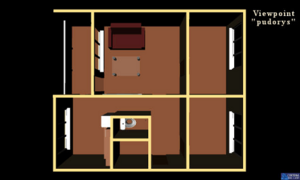VRML facts for kids

Apartment ground plan in VRML.
|
|
| Filename extension |
|
|---|---|
| Internet media type |
|
| Latest release |
2.0
|
| Type of format | 3D computer graphics |
| Extended from | Labyrinth |
| Standard | ISO/IEC 14772-1:1997 |
VRML (which stands for Virtual Reality Modeling Language) is a special computer language. It helps create 3D (three-dimensional) interactive worlds. These worlds can be viewed on the World Wide Web. People often say "vermal" or use its initials, "V-R-M-L". Before 1995, it was called Virtual Reality Markup Language. VRML has now been replaced by a newer language called X3D.
Contents
What Are VRML Files?
VRML uses text files to describe 3D objects. These files tell computers how to draw shapes. They include details like the points of a shape, its edges, and its colors. You can also add textures, shininess, and how transparent an object is.
Imagine a 3D world you can explore. In VRML, you can click on a 3D object. When you do, it might open a web page. Or it could take you to another VRML world. This makes the 3D experience interactive.
VRML worlds can also have Animations and sounds. Lights can be added to make the scene look real. These things can react to what a user does. They can also happen automatically, like with a timer. You can even add small bits of program code to a VRML file. This code can make the world do more complex things.
VRML files are often called "worlds." Their names usually end with ".wrl," like "island.wrl." These files are simple text. This means they can be made smaller using a tool called gzip. Smaller files travel faster over the Internet. Some compressed files use the ".wrz" extension. Many 3D modeling programs can create and save objects in VRML format.
Becoming a Standard
The Web3D Consortium is a group that helps develop 3D web technologies. They worked to improve VRML. The International Organization for Standardization (ISO) made VRML an international standard. This means it's a widely accepted way to create 3D content. Its newer version, X3D, is also an international standard.
The first version of VRML came out in November 1994. It was based on a system called Open Inventor. Later, a new version, VRML 2.0, was developed. This version became VRML97 (ISO/IEC 14772-1:1997). This is the most complete version of VRML.
How VRML Grew and Changed
The idea for VRML started in 1994. Dave Raggett first used the term "VRML" in a paper. This paper was presented at the first World Wide Web Conference. At that conference, Mark Pesce showed a cool 3D demo. It was called Labyrinth.
VRML became more widely known in 1995. Companies started making special software. This software allowed web browsers to show VRML worlds. For example, Template Graphics Software made a VRML plugin for Netscape Navigator.
In 1997, VRML97 became an ISO standard. Some websites, like "CyberTown," used VRML97. They even allowed people to chat in 3D worlds! However, VRML never became super popular. Many people at home had slow Internet connections. This made it hard to load complex 3D worlds.
Over time, other ways to create 3D graphics appeared. The Web3D Consortium then started working on X3D. X3D is the modern version of VRML. It can do everything VRML could and more.
VRML was often used in schools and for research. It was good because it was an "open specification." This means anyone could use and build on it. VRML is also used to share 3D models. These models often come from CAD systems.
There is a free version of VRML called OpenVRML. It helps add VRML and X3D support to applications. This means you can view VRML worlds in web browsers using a special plugin.
Other Ways to Make 3D for the Web
VRML was one of the first ways to create 3D content for the web. But over time, other technologies came out. Here are some of them:
- 3DMLW: A 3D Markup Language for Web.
- COLLADA: A format managed by the Khronos Group.
- O3D: Developed by Google.
- U3D: An international standard for 3D data.
- X3D: The direct successor to VRML.
Related Pages
- Active Worlds virtual reality – A platform for multi-user 3D chat.
- Additive Manufacturing File Format
- Blaxxun virtual reality – Another platform for multi-user 3D chat.
- Flux – A VRML/X3D editor and browser that is no longer available.
- List of vector graphics markup languages
- MeshLab – A free program that can export 3D models to VRML/X3D.
- OZ Virtual
- Seamless3d – Free 3D modeling software for Windows.
- STL – A common file format for 3D printing.
- Virtual Environment Software
- Virtual tour
- Web3D
- WebGL
- WebVR
- Documentation
See also
In Spanish: VRML para niños

